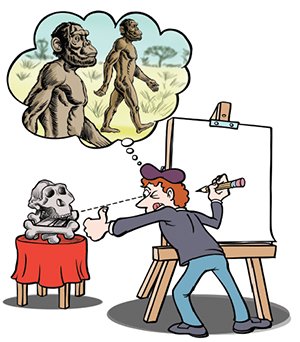Lesson 21: Where Did Humans Come From? Part 2
by Stacia McKeever and Dan Lietha on April 18, 2016“Know that the LORD, He is God; it is He who has made us, and not we ourselves; we are His people and the sheep of His pasture” (Psalm 100:3).

Looking a Little Closer
Evolutionists claim that humans and apes share a common ancestor that lived millions of years ago.
They say they have uncovered the fossils of supposed “apemen.” But the first apeman was described and drawn long before any bones were found. The drawing was based purely on the belief that things made themselves without God (evolution).
If evolution were true, there should be thousands of fossils showing the transition from apelike creatures to humans. However, the “missing links” turn out to be nothing more than bones of humans, or bones of some type of extinct ape. Even evolutionists themselves don’t always agree on how the bones should be interpreted!
We can’t go wrong if we trust in the Word of God, which never changes and never needs to be updated. It tells us that humans are not evolved animals, but were created in the image of God. Let’s take a look at some of the more famous apemen fossils, and find out what they really are.
Neanderthal Man
Neanderthal is German for Neander valley. This is where bones of this supposed “missing link” were first found about 150 years ago. Scientists now realize that Neanderthals were humans. They were our relatives—descendants of Adam and Eve (through Noah).
Java Man
He was first found in East Java over 100 years ago. Now that we have more of the bones, it is clear that his body was similar to ours. He walked just like we do. The same is true for Peking man, who was discovered in China during the 1920s and ‘30s. both are now called Homo erectus, or “upright man.” Recent evidence shows that modern-looking early humans had children by both Neanderthals and Homo erectus, showing that they are all fully human people groups.
“Lucy”
“Lucy” is among the more famous “missing links.” Careful research on the skull, inner ear, and other bones shows that Lucy is very similar to a pygmy chimpanzee. She did not walk upright like humans. Instead, she used her knuckles, like gorillas and chimps.
Want to learn more? Read the entire Answers for Kids Student Handout Set online!
Answers for Kids Student Handout Set
These student handouts reinforce the lessons of the Answers for Kids Bible Curriculum while providing fun activities for children.
Browse Kids BookRecommended Resources
- © 2024 Answers in Genesis
- Privacy Policy
- Contact
- About




